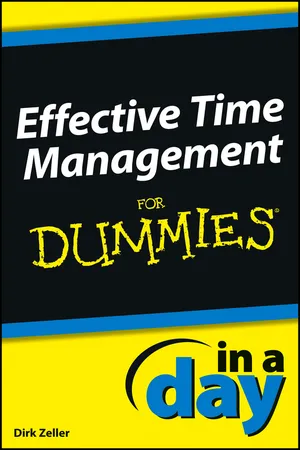Chapter 1
Setting Yourself Up for Success
In This Chapter



Time is the great equalizer — everyone has the same amount in a day. You may not have the power to get yourself more time, but you do have the power to make the most of it. You can take your 365 days a year, seven days a week, and 1,440 minutes in a day and invest them in such a way that you reap a return that fulfills your life and attracts the success you dream of.
That’s what this book is about: taking control of how you spend your time to make sure you’re using it the way you really want to. You really are in control of your time, even though you don’t always feel like it — even if you have a job that demands overtime; even if you have kids who keep you in the carpool loop; even if you have dreams and goals that involve developing new skills or furthering your education.
All in all, discovering how to manage your time well is part mental restructuring and part creating a system. Effective time management requires a little introspection, some good habits and organizational skills, and more than a few logistical and tactical tools. But all are achievable, and all are covered in this book.
Getting to Know Yourself
Although everyone gets the same number of hours to work with each day, what people don’t have in equal amounts are other valuable assets: skill, intelligence, money, ambition, energy, passion, attitude, even looks. All these unique reserves play into your best use of time. So the better you understand yourself — your strengths, weaknesses, goals, values, and motivations — the easier it is to manage your time effectively.
Assessing your strengths and weaknesses
Chances are that by this point in your life, you’ve discovered some skills that you come by naturally or perhaps have worked hard to acquire. Maybe you’re a master negotiator. Or a whiz with numbers. You may be a good writer. Or you may have a silver tongue. Whatever your strengths, developing the handful that brings you the most return on your efforts, propelling you forward to attain your goals, is a more productive course of action than trying to be the best at everything. For most people, these strengths typically number no more than a half-dozen.
In addition to pinpointing your strengths, you need to identify the areas where your skills are lackluster. Then figure out which tasks are essential for meeting the goals you want to accomplish, and build those skills. Invest time in honing and maintaining your strengths, and improve the weaknesses that you need to overcome to reach your goals.
Identifying your rhythm to get in the zone
Athletes talk about being in the zone, a place where positive results seem to stick like a magnet. Well, I’m here to tell you that the zone isn’t some magical place where wishes come true. Anybody can get there, without a lucky token or fairy dust. What it takes is focus, singular focus.
If you know your rhythms — when you’re most on, what times of day you’re best equipped to undertake certain tasks — you can perform your most important activities when you’re in the zone. Everyone works at a unique pace, and recognizing that rhythm is one of the most valuable personal discoveries you can make. Some of the aspects you need to explore in order to find your rhythm include the following:




Naming Goals to Give You Direction
Your goals can serve as inspiration in adopting good time-management skills. After all, managing your time isn’t really a benefit in and of itself, but managing your time so you can spend more of it doing what’s important to you is.
Using your aspirations to fire up your time management success means you have to identify your goals and keep them in the front of your mind. Draft a list of the 50 goals you want to achieve in the next 10 years by answering these five questions:









Your next task is to assign a time frame and category to each of your 50 goals. This step sharpens your focus and increases your intensity, which can reduce the time required to achieve your goals. Write a 1, 3, 5, or 10 next to each goal to indicate whether you want to achieve that goal within 1, 3, 5, or 10 years. For the category breakdown, your goals fall into one of six categories:
C = Career
F = Family
H = Health
M = Money/financial
P = Personal
S = Spiritual
Go through your list of 50 goals and write the appropriate category letter next to each one. At this point, you should have a list of 50 goals you want to accomplish over the next 10 years, all labeled according to the time frame you want to achieve them in and the aspect of your life that they fall under.
To whittle your long list of goals down to a manageable size — your top-12 — choose the three most important goals within each time frame: three that you want to achieve with...


